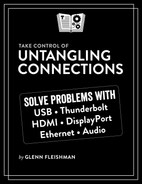Introduction
No computer is an island. Every computer needs to connect to other devices, whether internally or through external ports, to realize its potential fully. Even the original, all-in-one 128K Mac or the latest Apple silicon iMac requires an external keyboard and pointing device.
It’s a port-based world—and what wonders run over cables and adapters. You can buy a computer that can run four 6K external displays plus one at 4K, 10 Gbps Ethernet, and 40 Gbps Thunderbolt 4, and output 100 watts of power to connected devices.
Mobile devices were once an exception, as most people only plugged them into a power supply to charge or via a simple USB cable to sync—and less of the latter over time. But in 2022, many models of Apple and Android smartphones and tablets can connect via USB, Ethernet, HDMI, or DisplayPort with a suitable adapter.
The latest DSLR and mirrorless cameras aren’t excluded, either: they come with video output, like Micro HDMI, and a USB connection for data, remote control, and webcam input.
I know from over 40 years of working with computers and over 30 writing about them, on the list of the most frustrating situations you can encounter—appearing on the list after an unexpected software or operating system crash—is when you need to connect devices and come up empty.
This book focuses on managing connections by knowing what your device is capable of, what cable or adapter you need, and what peripherals you can attach. I’ll help you understand the basics of major standards. But my real goal is to solve problems and provide planning guidance for expansion and upgrades.
